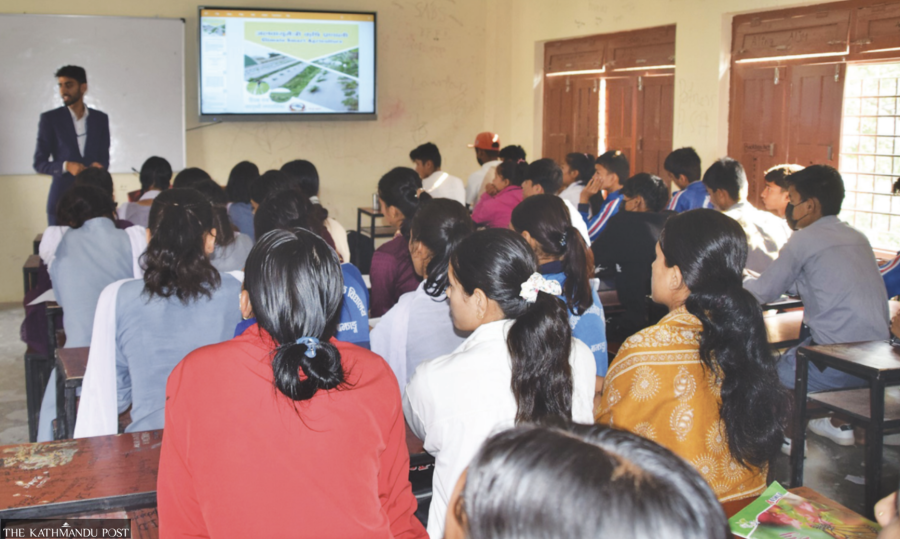Money
Bajhang farmers, students learning to cope with climate challenge
In the north-western corner of the country, one of the most vulnerable areas to climate change, farmers and students are being educated on climate impact mitigation.
Basant Pratap Singh
Lalita Bohora of Dhalaun in Saipal rural municipality has been doing a junior technical assistant course in agriculture for a year and a half at Jalpa Secondary School.
Bohora is learning how to plant crops, control pests, and other modern farming practices.
The field also demands she learn about climate change, an emerging issue threatening global agricultural production.
Nepal is one of the most vulnerable countries to climate change.
Changes in rainfall pattern, extreme weather incidents, and the proliferation of pests have been directly hitting crop production and threatening food security.
The course she is pursuing offers little knowledge about climate change, but a two-day training she attended recently was of some help.
“While studying the 10-month course, I learned new things, and practical know-how on crop plantation and harvest,” Bohora said. “The training I received on climate change was more useful.”
It taught them how to adapt farming techniques to the changing climate.
According to a new survey report, climate change has profound impacts on Nepal’s economy, particularly agriculture, water resources, and biodiversity.
The findings of the National Climate Change Survey 2022, the second of its kind, were recently released by the National Statistics Office, formerly the Central Bureau of Statistics. The report paints a bleak picture of Nepal's climate situation and urges necessary intervention for the resource-crunch Himalayan nation.
According to the survey, economic losses on and off-farm in the past five years, as reported by households, amounted to Rs415.44 billion. This does not include significant infrastructural damages.
In Nepal, the number of households unaware of the consequences of climate change is significantly high.
The survey shows that many households reported adverse weather changes. They noted that their water resources dried up, new diseases infected crops, productivity losses rose, and flowering and fruiting behaviours changed over the last two and a half decades.
According to the survey, over the past 25 years, approximately 50 percent of households reported the emergence of new diseases in their crops, 53.9 percent observed the presence of new insects or pests affecting their crops, and 29.8 percent of households noted the appearance of new diseases in their livestock.
Rural areas experienced more new diseases affecting crops (55.9 percent) than urban areas (45.6 percent). The mountain (68.7 percent), hill (50.3 percent), and Tarai (46.3 percent) regions also experienced an impact on crops due to new diseases.
Agriculture is the mainstay of Nepal’s economy. It contributes 24.60 percent to the country's GDP and employs over half the population. The sector is heavily dependent on rainfall.
For Susmita Thapa, a grade 12 student at Satyabadi Secondary School, receiving training on climate change has been an eye opener.
“We learned the inter-relation between agriculture and climate change,” said Thapa. “Our formal classes do not teach about climate change, its impact, and the ways to tackle it.”
Training participants said they have learned how to tackle climate change's impact on crops. Thapa also was informed on various climate adaptation measures. “The learning will be beneficial.”
Amid the growing impact of climate change on agriculture in recent years, farmers in Bajhang have been informed on the challenges and ways to tackle the emerging problem.
They have been acquainted with sustainable farming systems to boost output.
The training was supported by the Biodiversity (Jal-jangal) program of the USAID, Social Development Center, a local organisation.
“We stopped sowing local seeds after their yield declined. Now I know why this was happening,” said Birkha Mijar, a farmer in Thalara rural municipality Ward 9. “We knew what local seeds meant for sustainable farming. We also know the way to sow them. I will apply what I learned in the field.”
Kubendra Rokaya, an instructor, said he has trained 600 students and farmers in the district on mitigating the impacts of climate change on agriculture.
“Farmers in the far-western Nepal are unhappy as commercial farming is not very profitable. On top of that, climate distress has been a headache for farmers,” Rokaya said. “We can tackle the impacts of climate change by using local resources and technology. But many farmers are unaware of this.”
The training has taught them new practices.
“We have informed them on the impact of climate change at the local level, use of weather information, pest management, seed selection and early warning system,” Rokaya said.
Amit Banmala, coordinator of the Social Development Center Project, said students pursuing agriculture science and agriculture JTAs are Nepal's future guides to farming. Many of them are engaged in agriculture.
The agriculture sector in Bajhang faces drought in the winter and excessive rainfall in the rainy season.
According to the Agriculture Knowledge Centre, droughts last year reduced winter produce by 20 percent.
“Landslides and floods compound the problem in the agriculture sector every year,” said Tek Bahadur Bista, the centre’s chief.
“Farmers are facing additional trouble. It’s important for them to learn about mitigation measures.”




 9.88°C Kathmandu
9.88°C Kathmandu














